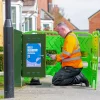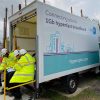BDUK Start New Batch of Phase 3A Project Gigabit Coverage Reviews

The Building Digital UK team has started a new batch of Open Market Reviews (OMR) under Phase 3A of the Government’s £5bn Project Gigabit broadband rollout, which will examine network coverage in Herefordshire, Cheshire, Gloucestershire and Lincolnshire and East Riding.
Just to recap. The project seeks to ensure that a minimum of 85%+ of UK premises can access a gigabit-capable broadband ISP connection by the end of 2025, before possibly reaching “nationwide” (c.99%) coverage by the end of 2030 (here and here).
Project Gigabit itself will be targeted at upgrading those in the final 20% of the UK (5-6 million premises), where commercial investment alone tends to fail (i.e. the hardest to reach rural and some sub-urban areas). But so far only £1.2bn of the proposed funding has actually been released for this, and the Government claims that more will follow if the industry shows it can deliver (i.e. depending upon the response to their procurements).
Advertisement
However, the first step – before procurements can begin and contracts be awarded to suppliers – is to identify precisely which areas are not expected to benefit from gigabit speeds under existing commercial builds or plans over the next 3 years (and beyond, if available). Only once you have the answer to that, can you identify where public funding will be needed to help address market failure.
The above process starts with an Open Market Review (OMR) and BDUK has just published a new batch (here), which covers all the aforementioned areas and is open for network operators to respond by 5pm on 6th May 2022. We’ve summarised the currently proposed plan for each of the areas below.
New Batch of Phase 3A OMRs for England – April 2022
Herefordshire (Lot 15)
Estimated contract commencement date: Jan – Mar 2024
Indicative contract value: £30m – £60m
Estimated number of uncommercial premises: 23,700Cheshire (Lot 17)
Estimated contract commencement date: Jan – Mar 2024
Indicative contract value: £85m – £144m
Estimated number of uncommercial premises: 74,300Gloucestershire (Lot 18)
Estimated contract commencement date: Jan – Mar 2024
Indicative contract value: £40m – £80m
Estimated number of uncommercial premises: 44,700Lincolnshire (including NE Lincolnshire and N Lincolnshire) and East Riding (Lot 23)
Estimated contract commencement date: Apr – Jun 2024
Indicative contract value: £106m – £180m
Estimated number of uncommercial premises: 105,700
We should point out that BDUK recently soft launched a new Rolling National Open Market Review, which should in the future make it easier for them to keep track of new developments in commercial builds of gigabit broadband networks. But in the meantime, they still have to run through the existing OMR and PR process.
Mark is a professional technology writer, IT consultant and computer engineer from Dorset (England), he also founded ISPreview in 1999 and enjoys analysing the latest telecoms and broadband developments. Find me on X (Twitter), Mastodon, Facebook, BlueSky, Threads.net and Linkedin.
« Vodafone UK Enhances Fixed Broadband and Mobile Bundles























































As indeed was reported on ISP Review back in May 2019, DCMS renamed BDUK from “Broadband Delivery UK” to “Building Digital UK” as part of a bit of a shake up.
I saw that only because if you follow the “Broadband Delivery UK” hypertext link you end up in a section of the GOV.UK website with the new “Building Digital UK” name!
Typo, corrected.
I’m confused about Project Gigabit. More specifically I’m confused as to how “local suppliers” can be value for money as generally they wouldn’t provide a wholesale solution.
In turn over time they’ll be a monopoly in areas whilst funded by the Gov.
Initially I thought they’d be used for wireless solutions covering large rural areas with few properties etc but recent publications regarding Phase1a (Cornwall) now indicate that local suppliers are now their preference over regional suppliers (ie OR, CityFibre, VM).
In short… any day the contract for Phase 1B Lot2 (Suffolk) should be announced and I’m concerned that whilst I live on an estate with OR FTTP next door (literally) I’m going to be covered by ‘BigJims Backshed Internet’ wireless solution that won’t have the range of capabilities or performance that OR or CF would provide.
(I keep checking daily to see if there’s new info on the Gov sites etc)
I’m confused as to why most London council areas don’t appear on either open reach or BDUK’s programme
I’m confused as to why most London council areas don’t appear on either open reach or BDUK’s programme